5 Understanding Accounting for the Billing Cycle
This chapter contains the following topics:
5.1 Billing AAI Rules
Accounting for the billing cycle is controlled by the billing AAI rules. The system uses the rules to:
-
Identify and process workfile transactions.
-
Direct the amount of the resulting journal entries to specific accounts.
You can define accounting entries using these rules:
-
Base rules, which you use to specify which accounts the system uses when creating journal entries for the billing and revenue recognition processes.
The system uses the base rule to create journal entries for the total of the base and component amounts.
-
Reallocation rules, which you use to move amounts from one account to another.
A reallocation rule consists of two or more offsetting journal entries that must balance. The first offset journal entry represents the reduction to the source account. The second journal entry represents the increase to the target account.
The Journal Generation Control field in the system constants for Contract Billing controls the types of billing AAI rules that you define for these processes:
-
Billing (Invoicing) only.
Revenue reconciliation is not applicable.
-
Revenue recognition only.
Revenue reconciliation is not applicable.
-
Revenue recognition and billing, including these types:
-
Without reconciliation of the accrued receivable account to the billed revenue and receivable accounts.
The accrued receivable account does not equal zero. Accrued receivable variances are allowed.
-
With reconciliation of the accrued revenue and accrued receivable amounts to the billed revenue and receivable amounts.
The accrued revenue and receivable amounts must equal zero after you generate the invoice. Accrued variances are not allowed.
-
5.2 Base Rules
Three types of billing AAIs are available for the system to use to create revenue recognition and invoice journal entries. The type of journal processing that you select in the system constants controls whether the system is restricted from using a specific table type. Each applicable type must contain a base rule that defines how the system creates journal entries.
This table shows the relationship between the Journal Generation Control field in the system constants and the billing AAI table number:
| Process | Journal Generation Control Setting | Billing AAI Table Number |
|---|---|---|
| Invoices only | 1 | 4811, Actual Revenue - Credit |
| Revenue recognition only | 2 |
|
| Invoices and revenue recognition without revenue reconciliation | 3 |
|
| Invoices and revenue recognition with revenue reconciliation | 4 |
|
|
Note: The system uses the RC AAI for accounts receivable when you generate invoices. The RC AAI does not apply if you are processing revenue recognition only. |
(Release 9.1 Update) This table shows how the system uses the base rules to create the accounting journal entries. The amount basis results from either the invoicing, revenue recognition, or cost process.
| Journal Generation Control | Process | Table Number | Debit/Credit Entry | Workfile Transaction Eligibility Code |
|---|---|---|---|---|
| 1
Invoices |
Invoice | 4811, Actual Revenue - Credit | Credit Entry | 1, Invoicing
4, Costing |
| Invoice | RC AAI | Debit Entry | ||
| 2
Revenue Recognition |
Revenue Recognition | 4832, Accrued Receivables | Debit Entry | 2, Revenue
4, Costing |
| Revenue Recognition | 4811, Actual Revenue - Credit | Credit Entry | ||
| 3
Invoice/Revenue Recognition without Reconciliation |
Revenue Recognition | 4832, Accrued Receivables | Debit Entry | 1, Invoicing
2, Revenue 4, Costing 0, Invoicing and Revenue |
| Revenue Recognition | 4811, Actual Revenue - Credit | Credit Entry | ||
| Invoice | 4811, Actual Revenue - Credit | Credit Entry | ||
| Invoice | RC AAI | Debit Entry | ||
| 4
Invoice/Revenue Recognition with Reconciliation |
Revenue Recognition | 4832, Accrued Receivables | Debit Entry | 1, Invoicing
2, Revenue 4, Costing 0, Invoicing and Revenue |
| Revenue Recognition | 4831, Accrued Revenue | Credit Entry | ||
| Invoice | 4811, Actual Revenue - Credit | Credit Entry | ||
| Invoice | 4831, Accrued Revenue | Debit Entry | ||
| Invoice | 4832, Accrued Receivables | Credit Entry | ||
| Invoice | RC AAIs | Debit Entry |
5.2.1 Example 1 - Invoicing Only
When you process invoicing only, this information is true:
-
The journal generation control is 1 (invoicing only).
-
Revenue recognition does not apply.
-
The system calculates the same amount for actual revenue and accounts receivable.
-
The system calculates the amounts for revenue and accounts receivable simultaneously.
-
The RC AAI designates the accounts receivable account.
For example, if the cost for a workfile transaction is 100.00 and the markup is 15 percent, the amounts for the invoice and accounts receivable are 115.00. The system creates these journal entries:
| Account | Debit | Credit |
|---|---|---|
| Accounts receivable | 115.00 | |
| Actual revenue | (115.00) |
This illustration shows the T-account postings in the general ledger:
Figure 5-1 T-account postings for example 1

Description of ''Figure 5-1 T-account postings for example 1''
The RC AAI directs the system to the accounts receivable account. Billing AAI table number 4811 directs the system to the base rules for the actual revenue account.
5.2.2 Example 2 - Revenue Recognition Only
When you process revenue recognition only, this information is true:
-
The journal generation control is set to 2 (revenue recognition only).
-
Invoicing does not apply.
-
The system calculates the same amount for actual revenue and accrued accounts receivable.
-
The system calculates the amounts for revenue and accrued accounts receivable simultaneously.
-
The RC AAI does not apply because no invoice exists.
For example, if the cost for a workfile transaction is 100.00, and the markup is 25 percent, the amounts for the accrued accounts receivable and actual revenue are 125.00. The system creates these journal entries:
| Account | Debit | Credit |
|---|---|---|
| Accrued accounts receivable | 125.00 | |
| Actual revenue | (125.00) |
This illustration shows the T-account postings in the general ledger:
Figure 5-2 T-account postings for example 2
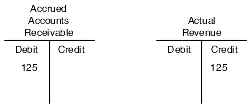
Description of ''Figure 5-2 T-account postings for example 2''
The system uses these AAIs to direct the system to create the journal entries:
-
Billing AAI table number 4832 directs the system to the base rules for the accrued accounts receivable account.
-
Billing AAI table number 4811 directs the system to the base rules for the actual revenue account.
5.2.3 Example 3 - Revenue Recognition and Invoicing Without Reconciliation
At times, a company might find it advantageous to allow a variance between invoices and the recognized revenue. For example, if the company recognizes revenue monthly, but generates invoices only after the work is completed, the revenue, accrued accounts receivable, and invoice accounts will:
-
Contain variances before the invoice journal is created.
-
Reconcile over time when all invoice journal entries for the completed project are generated and posted to the account ledger.
When you process revenue recognition and generate invoices without reconciliation, this information is true:
-
The journal generation control is 3 (revenue recognition and invoicing, without requiring revenue reconciliation).
-
Invoicing does not apply when you process revenue recognition.
-
The system calculates the same amount for actual revenue and accrued accounts receivable.
-
The system calculates the amounts for revenue and accrued accounts receivable simultaneously.
When the work is complete and you process invoices, the system:
-
Calculates the same amount for accrued accounts receivable and accounts receivable.
-
Calculates the amounts for accrued accounts receivable and accounts receivable simultaneously.
-
Uses the RC AAI to designate the accounts receivable account.
For example, suppose that your company began a project on June 15 and completed the project 90 days later. The total cost for the project was 1,000.00. Every week, the company generates the workfile transactions with a 15 percent markup added to the cost. Your company processes revenue recognition at the end of each month, beginning in June. It processes the invoice on September 25.
The system creates these journal entries for the project costs:
| G/L Date | Account | Debit | Credit |
|---|---|---|---|
| June 30, 2005 | Project cost | 350.00 | |
| June 30, 2005 | Accounts payable | (350.00) | |
| July 31, 2005 | Project cost | 500.00 | |
| July 31, 2005 | Accounts payable | (500.00) | |
| September 30, 2005 | Project cost | 150.00 | |
| September 30, 2005 | Accounts payable | (150.00) |
The account postings and balances in the general ledger for project costs are:
| Date | Debit | Credit | Balance |
|---|---|---|---|
| June 30, 2005 | 350.00 | 350.00 | |
| July 31, 2005 | 500.00 | 850.00 | |
| August 31, 2005 | 850.00 | ||
| September 30, 2005 | 150.00 | 1,000.00 |
The system uses these table types to direct the system to the base rules for the journal entries:
-
Billing AAI table number 4811, which directs the system to the base rules for actual revenue.
-
Billing AAI table number 4832, which directs the system to the base rules for accrued accounts receivable.
5.2.3.1 Revenue Recognition for June
On June 30, your company processes revenue recognition. The workfile contains a new transaction for 402.50. The system uses this calculation for the workfile transaction:
350.00 cost × 15 percent markup = 52.50
350.00 cost + 52.50 = 402.50
The system creates these journal entries for revenue recognition:
| G/L Date | Account | Debit | Credit |
|---|---|---|---|
| June 30, 2005 | Accrued Accounts Receivable | 402.50 | |
| June 30, 2005 | Actual Revenue | (402.50) |
This illustration shows the T-account postings in the general ledger:
Figure 5-3 June T-account postings for example 3
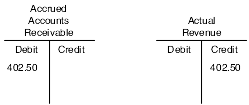
Description of ''Figure 5-3 June T-account postings for example 3''
The system uses these AAIs to direct the system to create the journal entries:
-
Billing AAI table number 4832 directs the system to the base rules for the accrued accounts receivable account.
It creates a debit journal entry for the revenue recognition amount.
-
Billing AAI table number 4811 directs the system to the base rules for the actual revenue account.
It creates a credit journal entry for the revenue recognition amount.
5.2.3.2 Revenue Recognition for July
On July 31, your company processes revenue recognition. The workfile contains a new transaction for 575.00. The system uses these calculations for the workfile transaction:
500.00 cost × 15 percent markup = 75.00
500.00 cost + 75.00 = 575.00
The system creates this journal entry for revenue recognition:
| G/L Date | Account | Debit | Credit |
|---|---|---|---|
| July 31, 2005 | Accrued Accounts Receivable | 575.00 | |
| July 31, 2005 | Actual Revenue | (575.00) |
This illustration shows the T-account postings in the general ledger:
Figure 5-4 July T-account postings for example 3
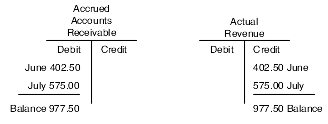
Description of ''Figure 5-4 July T-account postings for example 3''
The system uses these AAIs to direct the system to create the journal entries:
-
Billing AAI table number 4832 directs the system to the base rules for the accrued accounts receivable account.
It creates a debit journal entry for the revenue recognition amount.
-
Billing AAI table number 4811 directs the system to the base rules for the actual revenue account.
It creates a credit journal entry for the revenue recognition amount.
5.2.3.3 Revenue Recognition for August
In August, your company does not have new costs for the project. No new workfile transactions exist for the project.
This illustration shows the T-account postings and balance in the general ledger:
Figure 5-5 August T-account postings for example 3

Description of ''Figure 5-5 August T-account postings for example 3''
5.2.3.4 Invoicing for September
On September 25, your company processes the invoice. The workfile contains a new transaction for 172.50. The system uses these calculations for the workfile transaction:
150.00 cost × 15 percent markup = 22.501
50.00 cost + 22.50 = 172.50
The system creates this journal entry for the invoice:
| G/L Date | Account | Debit | Credit |
|---|---|---|---|
| September 25, 2005 | Accounts Receivable | 1,150.00 | |
| September 25, 2005 | Accrued Revenue | (1,150.00) |
The workfile transactions for June, July, and September have not yet been invoiced. The system adds the invoice amounts for the three months to create an invoice amount of 1,150.00.
This illustration shows the T-account postings in the general ledger:
Figure 5-6 Invoicing for September T-account postings for example 3
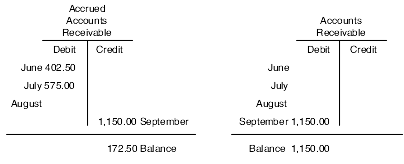
Description of ''Figure 5-6 Invoicing for September T-account postings for example 3''
The system uses these AAIs to direct the system to create the journal entries:
-
Billing AAI table number 4832 directs the system to the base rules for the accrued accounts receivable account.
It creates a credit journal entry for the invoice amount. The accrued accounts receivable account now contains an unreconciled balance of 172.50.
-
The RC AAI directs the system to the accounts receivable account.
It creates a debit journal entry for the invoice amount.
5.2.3.5 Revenue Recognition Adjustments for September
When you generate the journal entries for invoices, the system also generates adjustment journal entries for revenue recognition. The system uses the workfile transactions in the invoice batch to determine whether it must create any applicable adjustments to the prior journal entries for revenue recognition. Adjustments can occur for various reasons, such as:
-
You have not included invoiced workfile transactions for the current batch in a prior revenue journal.
-
The information for the workfile transaction, such as the object account, cost amount, or eligibility code, has changed from when you originally included it in a revenue batch.
The invoice was processed prior to the end of the month. Revenue has not been calculated for the 172.50 workfile transaction that was included in the invoiced amount. The system created this adjustment journal entry for revenue recognition:
| G/L Date | Account | Debit | Credit |
|---|---|---|---|
| September 25, 2005 | Accrued Accounts Receivable | 172.50 | |
| September 25, 2005 | Actual Revenue | (172.50) |
After you post the adjustment, the amount for actual revenue equals the amount for accounts receivable, and the variance for accrued accounts receivable self-corrects.
This illustration shows the T-account postings in the general ledger:
Figure 5-7 Revenue recognition adjustments for September T-account postings for example 3
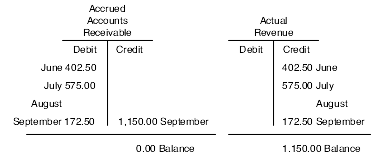
Description of ''Figure 5-7 Revenue recognition adjustments for September T-account postings for example 3''
The system uses these AAIs to direct the system to create the journal entries:
-
Billing AAI table number 4832 directs the system to the base rules for the accrued accounts receivable account.
It creates a debit journal entry for the revenue recognition amount.
-
Billing AAI table number 4811 directs the system to the base rules for the actual revenue account.
It creates a credit journal entry for the revenue recognition amount.
|
Note: Generally, during each month, a company processes multiple invoice batches. Depending on company policy, revenue recognition might be processed more than once a month. Timing differences always occur between revenue recognition and invoice processing. Therefore, the account for accrued accounts receivable would contain a variance amount and would not equal zero each month. |
5.2.4 Example 4 - Revenue Recognition and Invoicing with Reconciliation
Many companies do not want a variance between invoice and recognized revenue amounts. In this case, the revenue and receivable amounts are accrued estimates. The actual revenue and receivable amounts always equal the invoiced amounts. When the company processes invoices, all the estimates are reconciled.
For example, if the company recognizes revenue monthly, but generates invoices only after the work is completed, the estimated revenue and receivable amounts are reconciled when the actual revenue and receivable amounts for the invoice are processed.
When you process invoices with revenue reconciliation, the journal generation control is 4 (revenue recognition and invoicing, which requires revenue reconciliation).
When you process revenue recognition, this information is true:
-
Invoicing does not apply when you process revenue recognition at the end of each month.
-
The system calculates the same amount for accrued revenue and accrued accounts receivable.
-
The system calculates the amounts for accrued revenue and accrued accounts receivable simultaneously.
-
The system uses these table types for the billing AAI table to create the journal entries:
-
Billing AAI table number 4811 directs the system to the base rules for actual revenue.
-
Billing AAI table number 4832 directs the system to the base rules for accrued accounts receivable.
-
When the work is complete at a later time, and you process invoices, this information is true:
-
The system calculates the same amount for accrued accounts receivable and accounts receivable.
-
The system calculates the amounts for accrued accounts receivable and accounts receivable simultaneously.
-
The RC AAI designates the A/R account.
-
The system uses the billing AAI rules and AAIs to create the journal entries.
Billing AAI table number 4832 directs the system to the base rules for accrued accounts receivable and the RC AAI to the account information for accounts receivable.
The system also:
-
Processes the revenue reconciliation journal entries.
-
Reconciles the accrued revenue and receivable amounts.
-
Creates the actual invoice amounts.
-
Uses these table types for the billing AAI rules to create journal entries:
-
4811 to reconcile the actual revenue amounts.
-
4831 to credit the accrued revenue amount.
-
4832 to reconcile the accrued accounts receivable amounts.
-
For example, suppose that your company began a project on June 15 and completed the project 30 days later. The total cost for the project was 1,000.00. Every week the company generates the workfile transactions with a 15 percent markup that is added to the cost. Your company processes revenue recognition at the end of each month, beginning in June. It processes the invoice on July 25.
The system creates these journal entries for the project costs:
| G/L Date | Account | Debit | Credit |
|---|---|---|---|
| June 25, 2005 | Project Cost | 350.00 | |
| June 25, 2005 | Accounts Payable | (350.00) | |
| July 25, 2005 | Project Cost | 650.00 | |
| July 25, 2005 | Accounts Payable | (650.00) |
The Project Costs account postings and balances in the general ledger are:
| Date | Debit | Credit | Balance |
|---|---|---|---|
| June 25, 2005 | 350.00 | 350.00 | |
| July 25, 2005 | 650.00 | 1,000.00 |
5.2.4.1 Revenue Recognition for June
On June 30, your company processes revenue recognition. The workfile contains a new transaction for 402.50. The system uses this calculation for the workfile transaction:
350.00 cost × 15 percent markup = 52.50
350.00 cost + 52.50 = 402.50
The system creates this journal entry for revenue recognition for the accrued revenue and accrued accounts receivable:
| G/L Date | Account | Debit | Credit |
|---|---|---|---|
| June 30, 2005 | Accrued accounts receivable | 402.50 | |
| June 30, 2005 | Accrued revenue | (402.50) |
This illustration shows the T-account postings in the general ledger:
Figure 5-8 June T-account postings for example 4
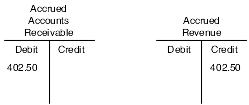
Description of ''Figure 5-8 June T-account postings for example 4''
The system uses these AAIs to direct the system to create the journal entries:
-
Billing AAI table number 4832 directs the system to the base rules for the accrued accounts receivable account.
It creates a debit journal entry for the revenue recognition amount.
-
Billing AAI table number 4831 directs the system to the base rules for the accrued revenue account.
It creates this credit journal entry for the revenue recognition amount.
5.2.4.2 Invoicing for July with June
On July 25, your company processes the invoice. The workfile contains a new transaction for 747.50. The system uses this calculation for the workfile transaction:
650.00 cost × 15 percent markup = 97.50
650.00 cost + 97.50 = 747.50
The system creates this journal entry for the June and July workfile transactions by adding the 402.50 and 747.50 that apply to the invoice:
| G/L Date | Account | Debit | Credit |
|---|---|---|---|
| July 25, 2005 | Accounts receivable | 1,150.00 | |
| July 25, 2005 | Accrued accounts receivable | (1,150.00) |
This illustration shows the T-account postings in the general ledger:
Figure 5-9 July T-account postings for example 4
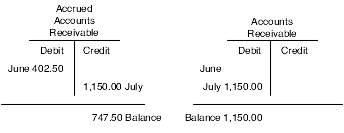
Description of ''Figure 5-9 July T-account postings for example 4''
The system uses these AAIs to direct the system to create the journal entries:
-
Billing AAI table number 4832 directs the system to the base rules for the accrued accounts receivable account.
It creates a credit journal entry for the invoice amount.
-
The RC AAI directs the system to the accounts receivable account.
It creates a debit journal entry for the invoice amount.
5.2.4.3 Revenue Reconciliation of the Revenue Amounts for July and June
During invoice processing, the system uses accrued accounts receivable as the clearing account for the revenue recognition and invoice amounts during the reconciliation of revenue.
The system creates these invoice journal entries for the reconciliation of the revenue recognition amounts:
| G/L Date | Account | Debit | Credit |
|---|---|---|---|
| July 25, 2005 | Accrued revenue | 1,150.00 | |
| July 25, 2005 | Revenue | (1,150.00) |
This illustration shows the T-account postings in the general ledger:
Figure 5-10 Revenue reconciliation for June and July T-account postings for example 4

Description of ''Figure 5-10 Revenue reconciliation for June and July T-account postings for example 4''
The system uses these AAIs to direct the system to create the journal entries:
-
Billing AAI table number 4831 directs the system to the base rules for the accrued revenue account.
It creates a debit journal entry for the revenue recognition amount.
-
Billing AAI table number 4811 directs the system to the base rules for the actual revenue account.
It creates a credit journal entry for the invoice amount.
After all the journal entries have been posted, the accrued accounts are reconciled. Only the actual revenue and accounts receivable accounts contain balances for the invoiced workfile transactions.
5.2.4.4 Revenue Recognition for July
Accrued accounts receivable and accrued revenue have not been calculated for the 747.50 workfile transaction that was included in the invoiced amount. The system creates this journal entry for reconciliation of the revenue recognition amounts:
| G/L Date | Account | Debit | Credit |
|---|---|---|---|
| July 25, 2005 | Accrued accounts receivable | 747.50 | |
| July 25, 2005 | Accrued revenue | (747.50) |
This illustration shows the T-account postings in the general ledger:
Figure 5-11 Revenue recognition for July T-account postings for example 4
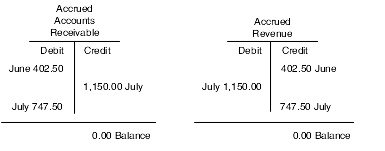
Description of ''Figure 5-11 Revenue recognition for July T-account postings for example 4''
The system uses these AAIs to direct the system to create the journal entries:
-
Billing AAI table number 4832 directs the system to the base rules for the accrued accounts receivable account.
It creates a debit journal entry for the revenue recognition amount.
-
Billing AAI table number 4831 directs the system to the base rules for the accrued revenue account.
It creates a credit journal entry for the revenue recognition amount.
5.3 Reallocation Rules
Companies can determine the need for reallocation rules by analyzing the accounting journal entries that are required when they post transactions that are processed by the JD Edwards EnterpriseOne Service Billing or Contract Billing systems.
5.3.1 Example 5 - Invoicing Only
A company creates an invoice for 1,200.00. The original cost per unit is 10.00 for 100 units. The cost of each unit is recorded in the Work in Process account. After the units are invoiced, the cost is moved from the Work in Process account to the Cost of Goods Sold account. Each unit is sold for 12.00.
The journal entries are:
| G/L Date | Account | Debit | Credit |
|---|---|---|---|
| June 30, 2005 | Work in Process | 1,000.00 | |
| June 30, 2005 | Accounts Payable | (1,000.00) | |
| July 31, 2005 | Accounts Receivable | 1,200.00 | |
| July 31, 2005 | Sales Revenue | (1,200.00) | |
| July 31, 2005 | Cost of Goods Sold | 1,000.00 | |
| July 31, 2005 | Work in Process | (1,000.00) |
Billing AAI table number 4811 first directs the 1,200.00 invoice amount to the Sales Revenue account. The system uses the AAIs to create the Accounts Receivable portion of the journal entry. Then, billing AAI table number 4841 reduces the Work in Process account by the cost amount and billing AAI table number 4842 increases the Cost of Goods Sold account by the cost amount.
The Work in Process account postings and balances for June in the general ledger are:
| Date | Debit | Credit | Balance |
|---|---|---|---|
| June 30, 2005 | 1,000.00 | 1,000.00 |
The Accounts payable account postings and balances for June in the general ledger are:
| Date | Debit | Credit | Balance |
|---|---|---|---|
| June 30, 2005 | 1,000.00 | (1,000.00) |
The Accounts Receivable account postings and balances for July in the general ledger are:
| Date | Debit | Credit | Balance |
|---|---|---|---|
| July 31, 2005 | 1,200.00 | 1,200.00 |
The Sales Revenue account postings and balances for July in the general ledger are:
| Date | Debit | Credit | Balance |
|---|---|---|---|
| July 31, 2005 | 1,200.00 | (1,200.00) |
The Work in Process account postings and balances for July in the general ledger are:
| Date | Debit | Credit | Balance |
|---|---|---|---|
| June 30, 2005 | 1,000.00 | 1,000.00 | |
| July 31, 2005 | 1,000.00 | 0 |
The Cost of Goods Sold account postings and balances for July in the general ledger are:
| Date | Debit | Credit | Balance |
|---|---|---|---|
| July 31, 2005 | 1,000.00 | 1,000.00 |
|
Note: In the example, the Journal Generation system constant is set to 1 because the company is creating invoices only without revenue recognition. Billing AAI table number 4811 is the only table that you need to create the revenue. Reallocation journal entries are made from billing AAI table numbers 4841 and 4842. |
5.3.1.1 Billing AAI Table Rules
You set up these billing AAI table rules for invoicing only:
| AAI Table Number | G/L Account | Debit/Credit Entry | Usage |
|---|---|---|---|
| 4811 | Actual Revenue - Credit | WDUTAM | Required |
| RC + G/L Class | Trade A/R | WDITOL | Required |
| 4841 | Work In Progress - Credit | WDAA | Optional |
| 4842 | Cost Of Goods Sold - Debit | WDAA | Optional |
|
Note: The RC AAI directs the system to the account information that is associated with the debit to Accounts Receivable. |
5.3.2 Example 6 - Revenue Recognition Only
A company recognizes revenue for 1,200.00. The original cost per unit is 10.00 for 100 units. The cost of each unit is recorded in the Work in Process account. After the revenue for the units is recognized, the cost is moved from the Work in Process account to the Cost of Goods sold account. The revenue for each unit is recognized as 12.00 per unit. Markup is 200.00.
The journal entries are:
| G/L Date | Account | Debit | Credit |
|---|---|---|---|
| June 30, 2005 | Work in Process | 1,000.00 | |
| June 30, 2005 | Accounts Payable | (1,000.00) | |
| July 31, 2005 | Accrued Receivable | 1,200.00 | |
| July 31, 2005 | Revenue | (1,200.00) | |
| July 31, 2005 | Cost of Goods Sold | 1,000.00 | |
| July 31, 2005 | Work in Process | (1,000.00) |
Billing AAI table number 4811 first directs the 1,2000.00 invoice amount to the Revenue account. Billing AAI table number 4832, Accrued Receivable, directs the 1,200.00 to the accrued receivable account. Then, billing AAI table number 4841 reduces the Work in Process account by the cost amount and billing AAI table number 4842 increases the Cost of Goods Sold accounts by the cost amount.
The Work in Process account postings and balances for June in the general ledger are:
| Date | Debit | Credit | Balance |
|---|---|---|---|
| June 30, 2005 | 1,000.00 | 1,000.00 |
The Accounts Payable account postings and balances for June in the general ledger are:
| Date | Debit | Credit | Balance |
|---|---|---|---|
| June 30, 2005 | 1,000.00 | (1,000.00) |
The Accrued Accounts Receivable account postings and balances for July in the general ledger are:
| Date | Debit | Credit | Balance |
|---|---|---|---|
| July 31, 2005 | 1,200.00 | 1,200.00 |
The Revenue account postings and balances for July in the general ledger are:
| Date | Debit | Credit | Balance |
|---|---|---|---|
| July 31, 2005 | 1,200.00 | (1,200.00) |
The Work in Process account postings and balances for July in the general ledger are:
| Date | Debit | Credit | Balance |
|---|---|---|---|
| June 30, 2005 | 1,000.00 | 1,000.00 | |
| July 31, 2005 | 1,000.00 | 0 |
The Cost of Goods Sold account postings and balances for July in the general ledger are:
| Date | Debit | Credit | Balance |
|---|---|---|---|
| July 31, 2005 | 1,000.00 | 1,000.00 |
5.3.2.1 Billing AAI Table Rules
You set up the billing AAI table rules for revenue recognition only as described in this table:
| AAI Table Number | G/L Account | Debit/Credit Entry | Usage |
|---|---|---|---|
| 4811 | Actual Revenue - Credit | WDBTOL | Required |
| 4832 | Accrued Receivables | WDBTOL | Required |
| 4841 | Work in Process - Credit | WDAA | Optional |
| 4842 | Cost of Goods Sold - Debit | WDAA | Optional |
5.3.3 Example 7 - Revenue Recognition and Invoicing Without Reconciliation
A company recognizes revenue for 1,200.00 over a two-month period. During the second month, the company processes an invoice for 1,200.00. The original cost per unit is 10.00 for 100 units. The cost of each unit is recorded in the Work in Process account. After the revenue is recognized for the units, the cost is moved from the Work in Process account to the Cost of Goods Sold account. The revenue for each unit is recognized as 12.00 per unit. The markup for June is 120.00 and the markup for July is 80.00.
The journal entries are:
| G/L Date | Account | Debit | Credit |
|---|---|---|---|
| June 30, 2005 | Work in Process | 600.00 | |
| June 30, 2005 | Accounts Payable | (600.00) | |
| June 30, 2005 | Accrued Receivable | 720.00 | |
| June 30, 2005 | Revenue | (720.00) | |
| June 30, 2005 | Cost of Goods Sold | 600.00 | |
| June 30, 2005 | Work in Process | (600.00) | |
| July 31, 2005 | Work in Process | 400.00 | |
| July 31, 2005 | Accounts Payable | (400.00) | |
| July 31, 2005 | Accounts Receivable | 1,200.00 | |
| July 31, 2005 | Accrued Receivable | (1,200.00) | |
| July 31, 2005 | Accrued Receivable | 480.00 | |
| July 31, 2005 | Revenue | (480.00) | |
| July 31, 2005 | Cost of Goods Sold | 400.00 | |
| July 31, 2005 | Work in Process | (400.00) |
During the revenue process for June, billing AAI table number 4811, Actual Revenue, first directs the 720.00 revenue amount to the Revenue account. Billing AAI table number 4832, Accrued Receivable, directs the 720.00 for accrued receivable to the Accrued Receivable account.
During invoicing with revenue recognition for July, the system uses the RC AAI to debit the Accounts Receivable account for the amount of the invoice. Then the system uses billing AAI table number 4832, Accrued Receivable, to create a 1,200.00 credit.
The system also determines whether the workfile transactions that make up the 1,200.00 invoice require any revenue adjustments. In this example, a 480.00 workfile transaction was not included in the revenue batch prior to creating the invoice. The system creates two additional journal entries for the revenue adjustments that are applicable to the workfile transaction.
The system uses billing AAI table number 4811, Actual Revenue, to adjust the 480.00 and to create a credit to the Revenue account. Then the system uses billing AAI table 4832, Accrued Receivable, to adjust accrued receivables by 480.00 and to create a debit to the Accrued Receivable account.
|
Note: In this example, the Accrued Receivable account reconciled to zero because of the timing difference between revenue recognition and invoicing. Typically, a variance would exist in the account each month because the system does not create reconciling entries to reconcile the accrued balance. |
Finally, billing AAI table number 4841 reduces the Work in Process account by the cost account each month, and billing AAI table number 4842 increases the Cost of Goods Sold account by the cost amount each month.
The Work in Process account postings and balances for June in the general ledger are:
| Date | Debit | Credit | Balance |
|---|---|---|---|
| June 30, 2005 | 600.00 | 600.00 |
The Accounts Payable account postings and balances for June in the general ledger are:
| Date | Debit | Credit | Balance |
|---|---|---|---|
| June 30, 2005 | 600.00 | (600.00) |
The Accrued Receivable account postings and balances for June in the general ledger are:
| Date | Debit | Credit | Balance |
|---|---|---|---|
| June 30, 2005 | 720.00 | 720.00 |
The Revenue account postings and balances for June in the general ledger are:
| Date | Debit | Credit | Balance |
|---|---|---|---|
| June 30, 2005 | 720.00 | (720.00) |
The Work in Process account postings and balances for June in the general ledger are:
| Date | Debit | Credit | Balance |
|---|---|---|---|
| June 30, 2005 | 600.00 | 600.00 | |
| June 30, 2005 | 600.00 | 0 |
The Cost of Goods Sold account postings and balances for June in the general ledger are:
| Date | Debit | Credit | Balance |
|---|---|---|---|
| June 30, 2005 | 600.00 | 600.00 |
The Work in Process account postings and balances for July in the general ledger are:
| Date | Debit | Credit | Balance |
|---|---|---|---|
| July 31, 2005 | 400.00 | 400.00 |
The Accounts Payable account postings and balances for July in the general ledger are:
| Date | Debit | Credit | Balance |
|---|---|---|---|
| June 30, 2005 | 600.00 | (600.00) | |
| July 31, 2005 | 400.00 | (1,000.00) |
The Accrued Receivable account postings and balances for July in the general ledger are:
| Date | Debit | Credit | Balance |
|---|---|---|---|
| June 30, 2005 | 720.00 | 720.00 | |
| July 31, 2005 | 1,200.00 | (480.00) |
The Revenue account postings and balances for July in the general ledger are:
| Date | Debit | Credit | Balance |
|---|---|---|---|
| June 30, 2005 | 720.00 | (720.00) | |
| July 31, 2005 | 480.00 | (1,200.00) |
The Accrued Receivable account postings and balances for July in the general ledger are:
| Date | Debit | Credit | Balance |
|---|---|---|---|
| June 30, 2005 | 720.00 | 720.00 | |
| July 31, 2005 | 1,200.00 | (480.00) | |
| July 31, 2005 | 480.00 | 0 |
The Work in Process account postings and balances for July in the general ledger are:
| Date | Debit | Credit | Balance |
|---|---|---|---|
| July 31, 2005 | 400.00 | 400.00 | |
| July 31, 2005 | 400.00 | 0 |
The Cost of Goods sold account postings and balances for July in the general ledger are:
| Date | Debit | Credit | Balance |
|---|---|---|---|
| June 30, 2005 | 600.00 | 600.00 | |
| July 31, 2005 | 400.00 | 1,000.00 |
5.3.3.1 Billing AAI Table Rules
You set up these billing AAI table rules for revenue recognition and invoicing without reconciliation:
| AAI Table Number | G/L Account | Debit/Credit Entry | Usage |
|---|---|---|---|
| 4811 | Actual Revenue - Credit | WDBTOL | Required |
| 4832 | Accrued Receivables | WDBTOL / WDITOL | Required |
| 4841 | Work In Process - Credit | WDAA | Optional |
| 4842 | Cost of Goods Sold - Debit | WDAA | Optional |
|
Note: The RC AAI directs the system to the Accounts Receivable account. It uses the invoice amount to create the debit for the journal entry. |
5.3.4 Example 8 - Revenue Recognition and Invoicing with Reconciliation
A company recognizes revenue for 1,200.00 over a two-month period. During the second month, the company processes an invoice for 1,200.00. The original cost per unit is 10.00 for 100 units. The cost of each unit is recorded in the Work in Process account. After the revenue is recognized for the units, the cost is moved from the Work in Process account to the Cost of Goods Sold account. The revenue for each unit is recognized as 12.00 per unit. The markup for June is 120.00 and the markup for July is 80.00.
The journal entries for June are:
| G/L Date | Account | Debit | Credit |
|---|---|---|---|
| June 30, 2005 | Work in Process | 600.00 | |
| June 30, 2005 | Accounts Payable | (600.00) | |
| June 30, 2005 | Accrued Receivable | 720.00 | |
| June 30, 2005 | Accrued Revenue | (720.00) | |
| June 30, 2005 | Cost of Goods Sold | 600.00 | |
| June 30, 2005 | Work in Process | (600.00) |
The Work in Process account postings and balances for June (revenue recognition) in the general ledger are:
| Date | Debit | Credit | Balance |
|---|---|---|---|
| June 30, 2005 | 600.00 | 600.00 |
The Accounts Payable account postings and balances for June (revenue recognition) in the general ledger are:
| Date | Debit | Credit | Balance |
|---|---|---|---|
| June 30, 2005 | 600.00 | (600.00) |
The Accrued Receivable account postings and balances for June (revenue recognition) in the general ledger are:
| Date | Debit | Credit | Balance |
|---|---|---|---|
| June 30, 2005 | 720.00 | 720.00 |
The Accrued Revenue account postings and balances for June (revenue recognition) in the general ledger are:
| Date | Debit | Credit | Balance |
|---|---|---|---|
| June 30, 2005 | 720.00 | (720.00) |
The Work in Process account postings and balances for June (revenue recognition) in the general ledger are:
| Date | Debit | Credit | Balance |
|---|---|---|---|
| June 30, 2005 | 600.00 | 600.00 | |
| June 30, 2005 | 600.00 | 0 |
The Cost of Goods Sold account postings and balances for June (revenue recognition) in the general ledger are:
| Date | Debit | Credit | Balance |
|---|---|---|---|
| June 30, 2005 | 600.00 | 600.00 |
In June, billing AAI table number 4811, Actual Revenue, first directs the 720.00 revenue amount to the Revenue account. Billing AAI table number 4831, Accrued Revenue, directs the 720.00 for accrued revenue to the Accrued Revenue account.
The journal entries for July are:
| G/L Date | Account | Debit | Credit |
|---|---|---|---|
| July 31, 2005 | Accrued Receivable | 480.00 | |
| July 31, 2005 | Accrued Revenue | (480.00) | |
| July 31, 2005 | Cost of Goods Sold | 400.00 | |
| July 31, 2005 | Work in Process | (400.00 | |
| July 31, 2005 | Accounts Receivable | 1,200.00 | |
| July 31, 2005 | Accrued Receivable | (1,200.00) | |
| July 31, 2005 | Accrued Revenue | 1,200.00 | |
| July 31, 2005 | Revenue | (1,200.00) |
The Work in Process account postings and balances for July (invoicing and revenue recognition) in the general ledger are:
| Date | Debit | Credit | Balance |
|---|---|---|---|
| June 30, 2005 | 600.00 | 600.00 | |
| July 31, 2005 | 400.00 | 1,000.00 | |
| July 31, 2005 | (400.00) | 600.00 | |
| July 31, 2005 | (600.00) | 0 |
The Cost of Goods Sold account postings and balances for July (invoicing and revenue recognition) in the general ledger are:
| Date | Debit | Credit | Balance |
|---|---|---|---|
| June 30, 2005 | 600.00 | 600.00 | |
| July 31, 2005 | 400.00 | 1,000.00 |
The Accounts Payable account postings and balances for July (invoicing and revenue recognition) in the general ledger are:
| Date | Debit | Credit | Balance |
|---|---|---|---|
| June 30, 2005 | 600.00 | (600.00) | |
| July 31, 2005 | 400.00 | (1,000.00) |
The Accrued Revenue account postings and balances for July (invoicing and revenue recognition) in the general ledger are:
| Date | Debit | Credit | Balance |
|---|---|---|---|
| June 30, 2005 | 720.00 | (720.00) | |
| July 31, 2005 | 480.00 | (1,200.00) | |
| July 31, 2005 | 1,200.00 | 0 |
The Accrued Receivable account postings and balances for July (invoicing and revenue recognition) in the general ledger are:
| Date | Debit | Credit | Balance |
|---|---|---|---|
| June 30, 2005 | 720.00 | 720.00 | |
| July 31, 2005 | 480.00 | 1,200.00 | |
| July 31, 2005 | 1,200.00 | 0 |
The Accounts Receivable account postings and balances for July (invoicing and revenue recognition) in the general ledger are:
| Date | Debit | Credit | Balance |
|---|---|---|---|
| June 30, 2005 | |||
| July 31, 2005 | 1,200.00 | 1,200.00 |
The Revenue account postings and balances for July (invoicing and revenue recognition) in the general ledger are:
| Date | Debit | Credit | Balance |
|---|---|---|---|
| June 30, 2005 | |||
| July 31, 2005 | 1,200.00 | (1,200.00) |
5.3.4.1 Billing AAI Table Rules
You set up these billing AAI table rules for revenue recognition and invoicing with reconciliation:
| AAI Table Number | G/L Account | Debit/Credit Entry | Usage |
|---|---|---|---|
| 4811 | Actual Revenue - Credit | WDBTOL | Required |
| 4831 | Accrued Revenue | WDBTOL / WDITOL | Required |
| 4832 | Accrued Receivables | WDBTOL / WDITOL | Required |
| 4841 | Work In Process - Credit | WDAA | Optional |
| 4842 | Cost of Goods Sold - Debit | WDAA | Optional |
|
Note: The RC AAI directs the system to the Accounts Receivable account. It uses the invoice amount to create the debit for the journal entry. |